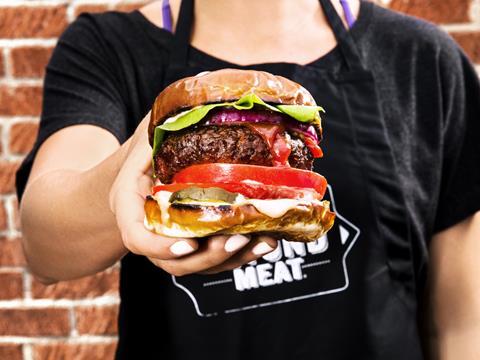
As food scientist Hanni Rützler bit down into the first ever lab-grown hamburger, cooked and served live on air in London back in 2013 complete with a bread bun and a single lettuce leaf, the world waited with bated breath.
Painstakingly created from 20,000 bovine muscle fibres grown in petri dishes, Rützler licked her lips and said the “intense taste” of the 140g patty came eerily close to conventional meat.
Almost as remarkable as the $300,000 burger was the claim from Dutch colleague Professor Mark Post that, far from being a pet project of a few boffins sponsored by a billionaire backer (later revealed as Google co-founder Sergey Brin) this so-called “cultured meat” would be mass produced and on supermarket shelves within two decades.
“My ambition is to gather a lot of people and a lot of money to do all the research required,” he added, so as to “take out all the small obstacles and get this on to your plates”.
Three years on, and a cluster of PR-hungry cultured meat startups are trying to do just that. And they claim Post’s 2033 prediction is positively pessimistic. Equipped with ultramodern websites and a slick social media presence, these new arrivals insist we could be grilling sausages and burgers, created without slaughtering a single animal, by 2022. All they need is our cash.
Zero animal suffering
Take SuperMeat, which stormed into the public consciousness in July with a crowdfunding bid for $500k. It wants the money to invest in the machinery it needs to produce cultured chicken - an “incredible and truly ground-breaking device that will grow real, tasty meat, with zero animal suffering,” says co-founder and CEO Koby Barak.
It’s an “animal-free, humane solution to world hunger and environmental degradation that will secure a better future for our children,” he adds, predicting that his chicken product will reach the market inside five years. But, given the speed of scientific breakthroughs in this area so far, how realistic is its 2022 prediction? What’s holding things back? How do vegans and vegetarians view this very modern take on meat. And how would you even market it?
Winston Churchill’s vision
It’s been more than 90 years since the concept of lab-grown meat gained its first high-profile supporter. In 1931, Winston Churchill proclaimed within 50 years “we shall escape the absurdity of growing a whole chicken in order to eat the breast or wing, by growing these parts separately under a suitable medium”.
His foresight was uncanny, but his timing was way off. It wasn’t until 68 years later, in 1999, when the man dubbed the ‘Godfather of cultured meat’, Dutch entrepreneur Willem van Eelen, followed decades of obsessive research by securing the first patent for commercialising cultured meat. Three years after that, a team from NASA dunked some cells from a freshly slaughtered goldfish into culturing fluid and grew brand new fish fillets from them. And it was 2003 before artists Oron Catts and Ionat Zurr grew a frog steak using amphibian cells and served it up, marinated in apple brandy, to French diners.
In the 13 years since, only a smattering of cultured meat products have been cooked up in labs, including professor Post’s 140g burger in 2013 and a single 28g meatball fried up by one of the latest arrivals, Memphis Meats, in January this year. But the science is almost there to scale up, insists CEO and co-founder Uma Valeti, who left a high-flying career in cardiology to set up the US company 12 months ago.
Taking up to three weeks to produce (compared with at least 23 weeks it takes to rear a cow for slaughter) their scientific process uses self-renewing animal cells to create “delicious-tasting meat that looks, smells and tastes like conventionally produced meat,” says Valeti.
Starting with “classic meat products” such as hotdogs, meatballs and sausages, he’s confident their products will be sat alongside conventional meat in supermarkets, restaurants and sports stadiums within a few years. But that kind of talk leaves Erin Kim, spokeswoman for non-profit scientific funding body New Harvest, nervous. “We’ve seen so many of those projected dates come and go,” she sighs. “There is a real risk of too much hype. And the other side of that is a trough of disappointment that could really hold back progress in the long run.”
How do you go from a cell in a petri dish to a big fat Juicy cheeseburger?
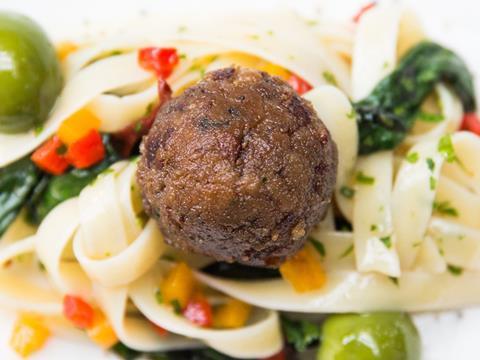
1. It all starts with a single cell
Scientists approach each stage of the process differently, but all must first source animal cells to culture, either extracted from a living animal by taking a sample of their tissue using a biopsy, or from the body of a slaughtered animal.
2. The type of cell may vary
Some opt for stem cells, which multiply quickly and can develop into any number of different cell types. Others opt for intermediate cells, midway between stem and muscle cells, where growth towards the desired muscle cell is slower but more predictable.
3. But they all need feeding…
Foetal Bovine Serum, the blood extracted from a calf foetus, is still used as the most common medium for this stage. But not only is it too pricey to be scaled up, it goes against the premise of slaughter-free meat. Researchers are looking for a suitable alternative.
4. Build a brewing chamber
Known as bio-reactors, they are now needed to create the right atmosphere in which the cells can absorb their ‘food’ and grow. To avoid contamination, scientists will need to be able to monitor every inch of these reactors - and a scaled-up version isn’t yet available.
5. Construct the final product
For a burger this is (relatively) simple, with scientists growing thousands of microscopic meat chunks that can be built into a burger. A more complex cut like a steak may require complex 3D structures to be built to which cells can attach, exercise and form into the right shape.
Big and bloody
New Harvest, a part-time project juggled by founder Jason Matheny with a high-profile role in US intelligence, only began funding cultured meat projects full time in 2013. And it’s maintained “a much more conservative approach in the messaging” too. “We don’t want to endanger the field by contributing to the bubble that’s starting to develop,” adds Kim.
The “media has gone so much quicker than the expertise,” says Abigail Glencross, a research fellow funded by New Harvest and one of the few PhD students developing the science of cellular agriculture. “I thought ‘Mark Post’s burger, what’s next?’ It’s taken me a year to realise the burger doesn’t exist in the way we think it does.”
“There is a real risk of too much hype, and the other side of that is a trough of disappointment that could really hold back progress in the long run”
As she’s discovered at each step of the process there is plenty more work to do. It’s one thing forming microscopic chunks of meat into passable burgers and meatballs, but quite another growing a lean fillet steak or a ribeye marbled with fat.
Huge bio-reactors in which culturing cells can grow, a little like vast brewing chambers, simply don’t exist to scale, explains future food scientist Dr Kurt Schmidinger. Test samples are currently grown in small reactors used for medical research. And to scale up cultured meat for supermarkets will require “huge reactors and the perfect atmosphere for which the cells to grow”.
And while minced meat can be imitated by building layer upon layer of cultured cell balls, a convincing steak needs an edible 3D structure around which cells can grow to take on the right muscular structure, or for cells to be 3D printed in layer upon layer into the right shape. And undoubtedly the biggest, bloodiest stumbling block is the ongoing use of foetal bovine serum, aka FBS. Harvested from the foetuses of dead cows, the costly serum is the most common medium on which many cultured animal cells feed, and grow. “Obscene” amounts were used by Professor Post and his team to build their burger in 2013, says Kim. And “for the moment” she says, cultured meat requires “more animal slaughter than a regular hamburger or steak”.
Animal suffering
So scientists are anxiously working on a replacement for FBS. New Harvest has provided $50,000 for Post to research alternatives. Memphis Meats says it will “never sell” a product that requires the serum and is “developing a serum-free media” to use in the R&D phase “as soon as possible”. SuperMeat says it has a “unique technology” that will replace FBS and give credibility to their claims that its cultured chicken will generate ‘zero per cent animal suffering’.
But at the moment, these lavish claims are “scientifically a little premature,” insists Kim. “We place a high importance on being honest and transparent about the real state of the science, which includes the fact that right now it depends on FBS.”
Without ditching this dependence on blood, it’s highly unlikely that cultured meat will ever get out the lab and into supermarkets. Not only are FBS costs high, but using blood goes against the fundamental premise of cultured meat as an ethical and sustainable alternative to the 56 billion animals farmed, slaughtered, processed and packed each year around the world.
It’s why PETA offered a $1m prize to the first laboratory to successfully cook up commercially viable cultured chicken in 2008. Nobody claimed the prize. But the animal rights group remains firmly behind the concept.
“For the moment, cultured meat requires more animal slaughter than a regular hamburger or steak”
“Ethical vegans didn’t stop eating animals because they didn’t like the taste of meat, but because they can’t stomach the suffering animals endure before their bodies are carved up for human consumption,” points out PETA associate director Elisa Allen.
“In vitro meat, which PETA US has been helping to fund for years, will spare animals the cruelty of factory farms, the terror of transportation, and a painful, frightening death in an abattoir. And people will be able to eat it with a clear conscience.”
And reducing reliance on livestock has arguably even bigger benefits environmentally. “One of the problems with animal farming is you put seven calories in to produce one calorie of meat,” says Schmidinger. “That’s five calories of shit, which is a huge waste of resources. If you don’t have to raise animals in factory farms it should be better for world nutrition.”
Once the favourite rant of vegan cowspiracists, the argument that current farming methods are hefty contributors to climate change has now found traction with the likes of think tank Chatham House. In its 2015 report, it argued the current “cycle of inertia” - where politicians fear the consequences of attempting to wrestle meat off its citizens - could keep global warming at a “danger level” because livestock is responsible for 15% of all emissions.
Even protein-packed Arnold Schwarzenegger has advocated part-time vegetarianism, dubbed flexitarianism, to address the threat. Record numbers of consumers have ditched meat altogether. And a surge of shockingly realistic plant-based alternatives to meat have hit the market too. But cultured meat offers the real thing with 90% less greenhouse gas emissions, claims Memphis Meats.
“Not only do we aim to reduce the risk of health issues associated with faecal contamination or illness, we also add benefits,” says Valeti. “Environmentally, we aim to produce meat that requires significantly fewer greenhouse gas emissions, less water, less land and less energy.”
Would vegans eat cultured meat?
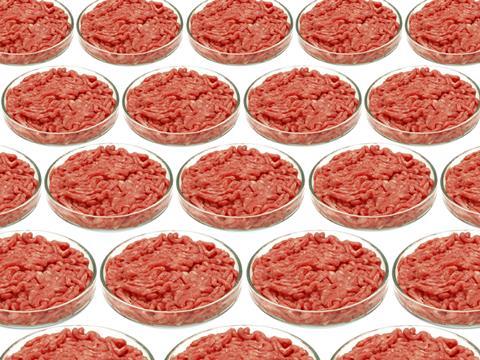
No animals will be harmed in the making of cultured meat. So can vegans and vegetarians tuck in too?
PETA UK says for those that made the switch for ethical reasons, slaughter-free cultured meat does make vegan friendly steaks and burgers perfectly possible. And with record numbers currently having a crisis of conscience when it comes to meat this could create a ready made market for cultured products.
More than a million in the UK are now vegetarian and a further half a million avoid animal products altogether, a 360% increase in veganism in the past decade. says the Vegan Society. “Veganism is one of the fastest-growing lifestyles in Britain, with at least 542,000 people now following a vegan diet, compared with 150,000 just a decade ago,” says campaign officer Elena Orde. “More and more people are now acting upon the health and environmental benefits of veganism, as well as becoming far more savvy about the realities of animal agriculture.”
But she isn’t convinced cultured meat presents a solution. “As cultured meat is made by initially using stem cells taken from an animal, it is not a product that can be considered vegan,” she says. “This would still be true even if every subsequent stage of the manufacturing process was vegan-friendly.”
And significantly 73% of vegetarians say they still wouldn’t touch the stuff in a poll by the Vegetarian Society.
A mug’s game
Still, sustainability scientist Braden Allenby urges caution. “Evaluating the economic, environmental, social, and cultural implications of any emerging technology is difficult and, beyond very limited bounds, a mug’s game,” he says. Producing meat in a controlled environment may, for instance, cut out waste materials, but requires vast amounts of energy to heat and cool animal cells. “The lesson of this scenario isn’t that in-vitro meat will have to use a lot of energy, only that naïve predictions that it won’t aren’t necessarily correct.”
Foolhardy or not, the potential it created for agriculture left Welsh farmer and Fortnum & Mason supplier Illtud Dunsford mopping up a nosebleed as he left the Maastricht conference on cultured meat in 2015.
“My head hurt so much from everything I’d learned over those three or four days,” he laughs. “It could revolutionise the meat industry because we’re a business that utilises whole carcases. We have to use every single piece of the animal. And in doing that we’re not a meat production business, we’re a waste management business. If we could just produce the product people want it would eliminate all those other pieces.”
It would also “pave the way for smaller herds, of lower density” and deliver “high levels of animal welfare, reducing the effect of these herds on soil erosion and water usage”.
Dunsford was the lone industry voice at the first UK gathering of cultured meat specialists in December, so he’s under no illusion he has the industry to convince. Though some mega meat processors have shown willingness to engage in meat alternatives, with US giant Tyson Foods ploughing an undisclosed sum into ‘bleeding’ plant burger producer Beyond Food, many in the UK’s £7.3bn meat industry remain flummoxed as to why any consumer wouldn’t stick with the real deal.
The yuck factor
“Personally, I find the whole idea unappealing,” says AHDB director of market development Nick Allen. “I would much rather enjoy the real thing than a processed substitute like this. I don’t think they should be allowed to call this meat. What they are making is an artificial product - it’s definitely not meat. Meat is something that comes from an animal and not something that is created on a lab bench.”
He also believes there will be a “significant ‘yuck’ factor for many consumers because of its artificial nature. Would you want to eat a processed substitute produced in a laboratory or meat that has grazed in the great British countryside?”
Exclusive research for The Grocer by Harris Interactive backs up those doubts. Only 16% of people say they’d be happy to try cultured meat, according to a survey of more than 2,000 adults, with 50% refusing to even consider it. Fifty-six per cent cited anxiety over potentially dodgy chemicals as putting them off, with long-term side effects (49%), the fact cultured meat wasn’t ‘natural’ (48%) and poor taste (29%) also major factors.
“I don’t think they should be allowed to call this meat. Meat is something that comes from an animal and not something that is created on a lab bench.”
“When we delve deeper into attitudes by gender and age, there is a distinct difference,” says head of CPG and retail research Lucia Juliano. She says far more men (24%) are open to the idea than women (9%) and the over-55s (4%), who are most averse to tucking into a cultured hamburger. So those consumers “will need to be the focus of any campaigns to educate and allay fears,” advises Juliano.
With only 61% of Brits even aware cultured meat exists, it appears “we are quite simply opposed to the idea of cultured meat without knowing much about it,” she adds. “Better education around what cultured meat is, the need for it, and the benefits it could have may encourage those who are unsure to be more open to the idea.”
That said, a shift is underway, believes Kim. “Even in the past two years I’ve seen the public conversation take a more positive direction,” she says. “A few years ago you’d hear ‘Frankenmeat’ or ‘test tube meat’. Now the language is more scientifically grounded.”
And recent crowdfunding campaigns have intrigued consumers enough to part with their money. SuperMeat’s crowdfunding bid platform on Indiegogo - strapline ‘REAL meat, without harming animals’ - stands at $223,340 after six months. And 1,453 backers at the time of going to press have donated a total of $100,000 to Memphis Meats in less than two months.
“What we’re finding is the more people become aware of our innovations, and their potential for the world, the more overwhelmingly enthusiastic they become for our products,” says Valeti. “Our job is to get information out there and get conversations started.”
Brilliant brand designs, such as those dreamed up by agency Path for The Grocer may help.
Vision or fantasy
Others suggest looking to the success of Quorn for inspiration. As unappetising as fungus fermented in 155,000-litre tanks before minute fibres are layered into a meat-like texture sounds, the vegetarian alternative has successfully pitched itself to consumers as an all-natural protein, pulling in Olympic hero Mo Farah to highlight its healthy credentials, resulting in £158m of sales, up 5.2%, in its latest accounts.
And nearly a third (29%) of consumers say any added health benefits could bring them round to the idea of cultured meat. “You could leave out the cholesterol, or the fatty saturated acids and replace with omega-3,” suggests Schmidinger. “It’s much easier to influence the product in such a technology.”
The potential makes recipes plucked from the realm of “vision and fantasy” possible. Meaty cocktails of endangered crocodiles or kangaroos cultured in bio-reactors could be served up in supermarkets without spilling a drop of blood, he adds. Or even, as the designs dreamed up by Path suggest, steaks that take ‘rare’ to a whole new level.
“If you want to succeed with cultured meat it has to be economically viable and competitive with what you want to replace”
But none of this matters unless scientists get the price right. Though Memphis Meats says it has seen “significant reductions” in the cost of production in recent months, its products remain far too pricey for the market. And “if you want to succeed with cultured meat it has to be economically viable and competitive with what you want to replace”, says Schmidinger.
That’s before you even begin to take on the might of the meat industry. “Canal shippers fought the railroad, old media fought new media, and we can bet that beef, pork, and poultry interests will likely do the same,” says Allenby. “That makes any timeline predictions dicey.”
Ultimately better science, marketing, cash and, in all likelihood, a lot more blood will be needed to get competitively priced cultured burgers near the supermarket. Any one of which could throw up serious obstacles to the ambitions of cultured meat’s latest cohorts.
Move over Quorn: next gen meat-free alternatives
It’s not just cultured meat, grown from cells in labs, that could offer up a realistic alternative to a normal burger. Celebrity investors are pouring big money into high-profile projects in which juicy burgers are made from plants. Progress may be slow, but plant-based patties are already appearing on restaurant menus and on supermarket shelves. Here are some of the most successful to date…
Impossible Foods

Backed by Bill Gates, Impossible Foods has delivered a suitably hi-tech solution. Using iron-rich compound heme, a component abundant in real meat, makes it “smell, sizzle, bleed, and taste gloriously meaty”, resulting in a ‘bleeding’ plant burger that has left vegetarians (and meat-eaters) raving. Available in only three US restaurants so far, the company has secured $182m in equity since its 2012 launch.
Beyond Meat
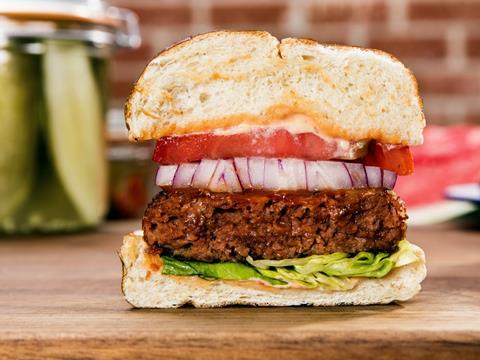
As of December, nearly 200 US Whole Foods Market stores will be selling the Beyond Burger, a ready-to-cook raw patty billed as the “world’s first plant-based burger that looks, cooks, and tastes like a fresh beef burger”. Built with pea protein and made to ‘bleed’ using beetroot, the burger is one of 12 SKUs developed by Beyond Foods, which also includes Beyond Beef Crumbles and Beyond Chicken Strips.
More than Meat

These burgers, sausages and casseroles launched into delis and vegan supermarkets in the UK in September 2015. Made using wheat protein, beans, nutritional yeast and flours and cooked in small batches, the More Than Burger contains 99% less satfat and 38% more protein than a Waitrose beefburger, while its Lamb Casserole has 76% less salt and 96% less satfat than a Waitrose lamb hotpot.
Mheat
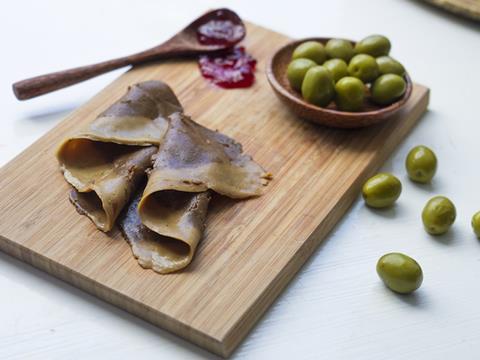
Selling slabs of meatless Mheat wrapped in authentic butcher’s brown paper, the two Italian expats behind Sgaia Foods have billed themselves “the first vegan travelling butcher shop”. Moving between UK foodie markets and festivals, as well as appearing on restaurant and café menus, Mheat uses wheat gluten as the core product in its handmade steaks, burgers, rashers and pastrami.
Fry Family Food
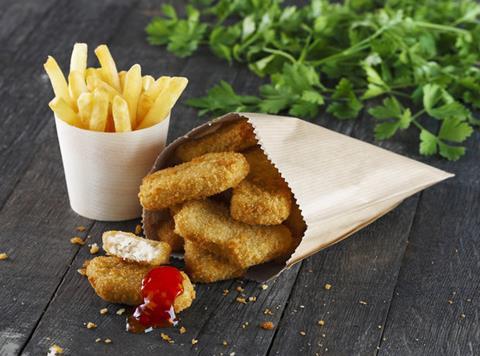
Fry Family Food added to its range of veggie alternatives in 2015, stocked in Morrisons, Ocado and Whole Foods Market, with a gourmet collection of nuggets, schnitzels and stir-fry strips made using a mix of rice protein, quinoa, chia seeds and flaxseed. “Sustaining and sustainable, these new foods contain superfoods for superior taste and contain hearty plant proteins that do no harm,” says the company.
Anyone for panda steaks?

The Grocer commissioned creative agency Path to dream up some visions that would illustrate the opportunities cultured meat present. And it makes zero apologies for its first concept, Rare, a “highly provocative head-turner,” says the agency’s Tim Bousfield, which offers up endangered panda steaks in premium packs. With no animals harmed in its making, snow leopard steaks or blue whale burgers could also be created, to “play with people’s default programming and shift perceptions” - turning a no-no into a delicacy. “You’d stop dead in your tracks outside the butcher,” adds Boulsfield. And “on shelf it would cause an absolute furore”.
Originally presented in a classic elegant pack, the designers “decided to give it both barrels” by adding the further provocation of panda fur to its packaging.
Mixed with “the classic regular structural pack, we wanted to root in people’s consciousness that this is regular meat, impossibly produced”.
Best suited to premium spots in Marks & Spencer, Waitrose or even Harrods, this is a product for that special occasion, says the agency, comparable with the increasing appetite for exotic meats like ostrich, zebra and giraffe. Ultimately “panda meat tastes great, better than rump steak, and with this technology you get the best of both worlds”.
Me@: a tailored diet for millennials

Targeted at millennials, Path’s second concept, Me@, is an ultra-modern brand that aims to play to the growing trends for both wearable tech and personalised foodie experiences.
Donning a Smartwatch that scans heart rate, blood pressure and calorific intake, users will be able to order meat tailored to their own individual biological needs. Using cultured meat technologies, which theoretically enable scientists to better influence the health benefits of the meat make-up, vitamin D, iron, omega-3 or more could all be added depending on an individual’s specific deficiencies or needs. “You get this bespoke product that comes back that harmonises with your biology.”
Sent back in “impossibly perfect” cubes, the product won’t attempt to imitate conventional meat - instead embracing its scientific origins by arriving in a geometric form. “The style is one of modernistic elegance, that is purposively different from the Rare proposition,” explains Bousfield.
“This isn’t from the butchers, instead it pitches factories and labs as places that are to be embraced for the ability to create exactly what you need. There is a sense that this isn’t meat, this is lab-grown meat and feels different.”
And how else would you deliver cubic cultured meat than with a futuristic drone that lands right outside your front door?
In doing so, even the way you shop for your Me@ will be “tailored exactly how you want it - without needing to visit the supermarket aisles”.
The revolution made flesh

“Gutsy, socialist, meat for the masses,” is how designers Path describe its third concept: the Animal Pharm brand.
Both “purposely functional” in its packaging and with “a vibe suggestive of a bold collective or organisation,” this design is the most political of the three.
Tapping into the democratisation of meat that cultured tech provides, by allowing even vegetarians and vegans to enjoy a juicy fillet steak, the brand plays on a “sense of revolution and social reforming,” says Bousfield, with its ‘Ph’ alluding to the world of science and labs. “Central to it is saying guess what you two tribes, meat lovers and veggies, we can bring you together with this fantastic democratising product. We’re going to have a product everyone can enjoy because meat tastes great, and in its purest form I defy anyone to turn their back on a bacon sandwich. We’ve removed the squeamishness and animal welfare concerns, but preserved the pure hedonistic taste of a meat product.”
That socialist attitude feeds through to the bold orange pack, while off-pack (left), the poster-based marketing is a “revolutionary call to action”.
Neither economy nor premium, this brand resides in the middle tier, says the agency, and would sit comfortably in the equally democratic supermarket shelves of the major mults.









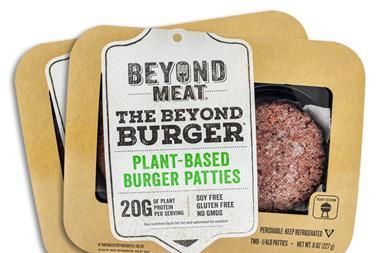
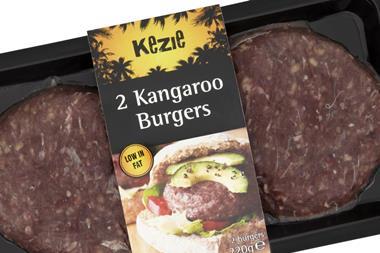
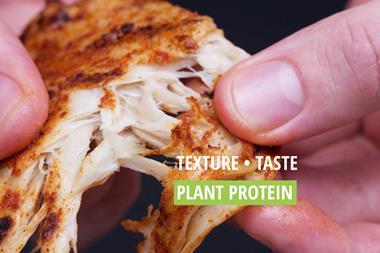
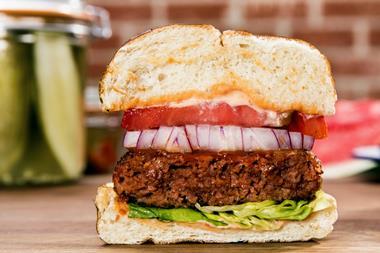






No comments yet